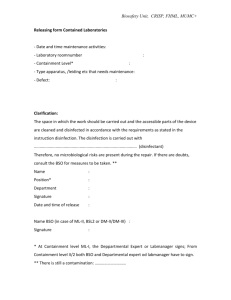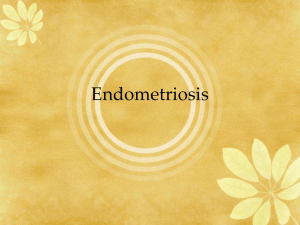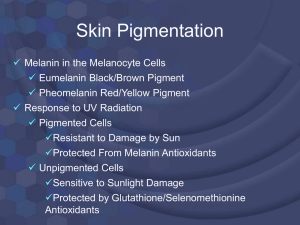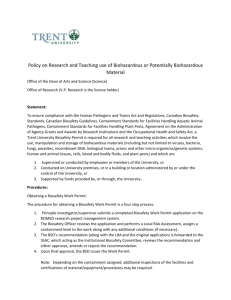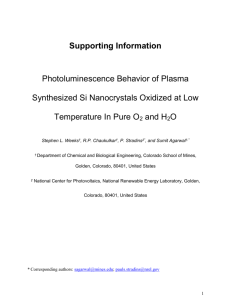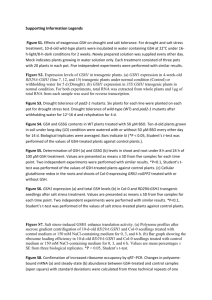BMCL-BSO_melanins-Rev... - digital
advertisement
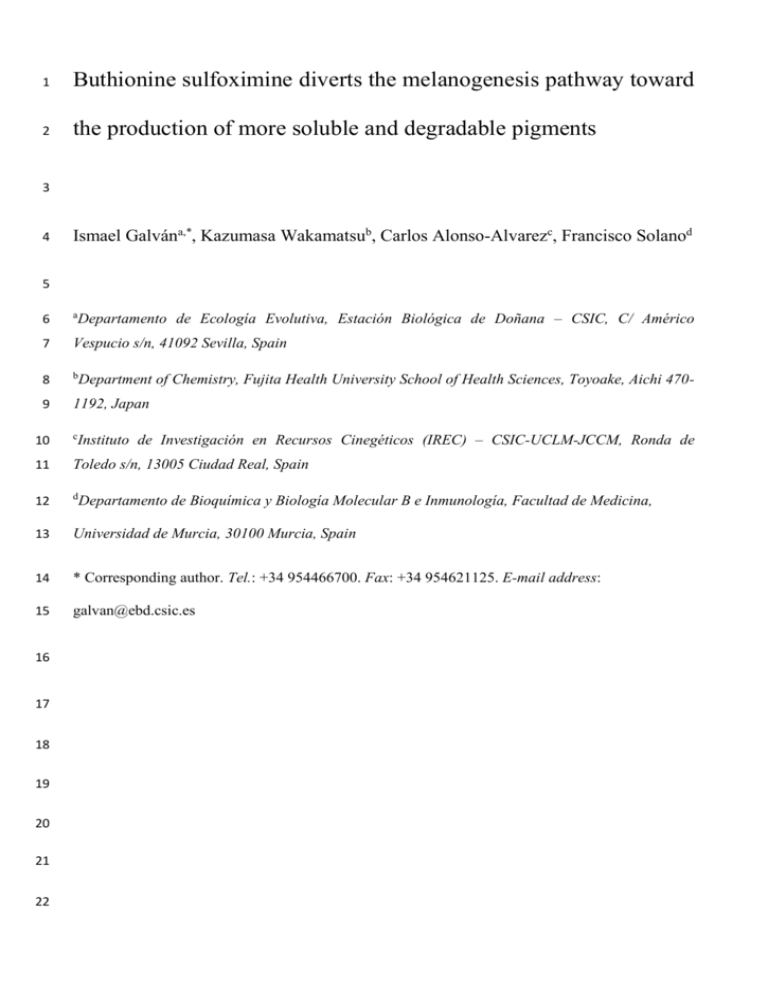
1 Buthionine sulfoximine diverts the melanogenesis pathway toward 2 the production of more soluble and degradable pigments 3 4 Ismael Galvána,*, Kazumasa Wakamatsub, Carlos Alonso-Alvarezc, Francisco Solanod 5 Departamento de Ecología Evolutiva, Estación Biológica de Doñana – CSIC, C/ Américo 6 a 7 Vespucio s/n, 41092 Sevilla, Spain 8 b 9 1192, Japan Department of Chemistry, Fujita Health University School of Health Sciences, Toyoake, Aichi 470- Instituto de Investigación en Recursos Cinegéticos (IREC) – CSIC-UCLM-JCCM, Ronda de 10 c 11 Toledo s/n, 13005 Ciudad Real, Spain 12 d 13 Universidad de Murcia, 30100 Murcia, Spain 14 * Corresponding author. Tel.: +34 954466700. Fax: +34 954621125. E-mail address: 15 galvan@ebd.csic.es 16 17 18 19 20 21 22 Departamento de Bioquímica y Biología Molecular B e Inmunología, Facultad de Medicina, 23 ABSTRACT 24 Buthionine sulfoximine (BSO) is a specific inhibitor of γ-glutamylcysteine synthetase, thus 25 blocking the synthesis of glutathione (GSH). It is known that this makes that BSO affects melanin 26 synthesis because of the role of thiols in melanogenesis. However, BSO may also react with the 27 intermediate oxidation products of melanogenesis, a possibility that has not been investigated from 28 the initial steps of the pathway. We created in vitro conditions simulating eumelanogenesis 29 (oxidation of L-DOPA in the absence of GSH) and pheomelanogenesis (oxidation of L-DOPA in 30 the presence of GSH) under presence or absence of BSO. BSO made that eumelanogenesis results 31 in pigments more soluble and less resistant to degradation by hydrogen peroxide than pigments 32 obtained without BSO. A similar but less marked effect was observed for pheomelanogenesis only 33 at subsaturating concentrations of GSH. These results suggest that BSO diverts the melanogenesis 34 pathway toward the production of more soluble and degradable pigments. 35 36 37 38 39 40 41 42 43 44 45 46 47 48 49 50 51 Buthionine sulfoximine (BSO) is a specific inhibitor of γ-glutamylcysteine synthetase, the enzyme 52 that catalyzes the rate-limiting step in the synthesis of glutathione (GSH), where two of its three 53 constitutive amino acids (glutamate and cysteine) are bonded1. BSO thus decreases intracellular 54 GSH levels with no side, toxic effects2-4. The important antioxidant activity of GSH makes that 55 BSO inhibits the growth of different tumour cell lines and increases their sensitivity to 56 antineoplastic drugs5. The inhibitory effect of BSO is particularly high against melanoma-derived 57 cell lines6, as melanoma may be dependent on the role of GSH and its linked enzymes in melanin 58 synthesis7. However, the effect of BSO on the synthesis of different types of melanin has received 59 little attention. This may have important consequences for understanding possible side effects of 60 BSO use. 61 The first step in the melanogenesis pathway, catalyzed by the enzyme tyrosinase, is the 62 oxidation of the amino acid L-tyrosine to L-dopaquinone (see Fig. 1) which undergoes an 63 intramolecular cyclization of the amino group to give L-dopachrome via L-cyclodopa, which in turn 64 suffers a redox exchange with L-dopaquinone that produces L-dopachrome and 3,4-dihydroxy-L- 65 phenylalanine (DOPA)8. In this process, the recruiting of L-DOPA to be re-oxidized to L- 66 dopaquinone is again catalyzed by tyrosinase, so that half of the DOPA oxidized to L-dopaquinone 67 is reduced back to DOPA. L-Dopaquinone is the common precursor of the two connected 68 biosynthetic routes in melanogenesis that lead to the formation of either eumelanin or 69 pheomelanin9. In the absence (or below certain concentration) of sulfhydryl groups from thiol 70 compounds such as cysteine or GSH, dopachrome evolves to two dihydroxyindoles, DHICA (5,6- 71 dihydroxyindole-2-carboxylic acid) or DHI (5,6-dihydroxyindole) by tautomerization or 72 decarboxylation, respectively. The resulting DHI/DHICA ratios depend on the level of dopachrome 73 tautomerase activity and/or the presence of some metal ions10. DHICA and DHI are further oxidized 74 and polymerized to form eumelanin (Fig. 1). In the presence (or above certain concentration) of 75 sulfhydryl-containing compounds, these conjugate with L-dopaquinone to generate mainly 5-S- 76 cysteinyldopa (in the presence of cysteine) or 5-S-glutathionyldopa (in the presence of GSH). These 77 and other thiol-DOPA conjugates are further oxidized and polymerized to form pheomelanin8-9,11 78 (Fig. 1). Given this biochemical process, the reduction of GSH levels exerted by BSO should 79 decrease pheomelanin production and increase eumelanin production. 80 However, the effect of BSO on the synthesis of melanins may not be only mediated by the 81 inhibition of γ-glutamylcysteine synthetase and cysteine production, because the S=NH group of 82 BSO may also behave as the sulfhydryl groups (S-H) of cysteine and GSH, and thus BSO may react 83 directly with some of the intermediate oxidation products of the melanogenesis pathway and that 84 would affect the production of pigments. To investigate the latter possibility, we conducted an in 85 vitro experiment to go deeper into the chemical reactivity properties of BSO. Benathan and 86 coworkers12-13 have previously reported increases in the pheomelanin precursor 5-S-cysteinyldopa 87 and decreases in total pigmentation in in vivo cells exposed to BSO. However, the possibility that 88 the S=NH group of BSO reacts with melanogenesis intermediates has never been explored. The 89 expectation should be that BSO reacts with dopaquinone to form BSO-DOPA conjugates and thus 90 diverts the melanogenesis route, decreasing the synthesis of both pheomelanin and eumelanin 91 similarly to other agents containing sulfhydryl groups14. 92 To investigate the possibility that BSO reacts with intermediates of the melanogenesis 93 pathway, we reproduced under in vitro conditions the initial steps of the melanogenesis pathway 94 oxidizing L-DOPA with tyrosinase in the presence or absence of GSH, and in the presence or 95 absence of BSO. The oxidation of L-DOPA without GSH should thus be similar to 96 eumelanogenesis, while the oxidation of L-DOPA in the presence of GSH should simulate 97 pheomelanogenesis11. We used GSH instead of cysteine as a sulfhydryl compound because the 98 former is more abundant in intracellular media than free cysteine, so pheomelanogenesis in the 99 presence of GSH may resemble more closely the in vivo situation9. In any case, 5-S- 100 glutathionyldopa, which is the major thiol-conjugated species formed when L-dopaquinone reacts 101 with GSH, releases 5-S-cysteinyldopa15, the main intermediate of the monomeric subunits for 102 pheomelanin, after the action of a dipeptidase and the pathway then progresses as when only 103 cysteine is present9. 104 To explore the influence of BSO on melanogenesis, five solutions were prepared in 105 cryogenic vials all containing 10 mM L-DOPA11,16 and 90 mM BSO (DL-buthionine-(S,R)- 106 sulfoximine) in 1 ml of saline phosphate buffer (4mM KHCO3, 2mM CaCl2 2H2O, 20mM NaHCO3, 107 138mM NaCl and 2mM KCl), pH 7.4. One of these solutions did not contain GSH, other two 108 solutions contained GSH at concentrations (0.65 and 3.2 mM) that were lower than the 109 concentration of the substrate L-DOPA, and finally other two solutions contained GSH at 110 concentrations (16.3 and 81.3 mM) that were higher than the concentration of the substrate L- 111 DOPA but lower than that one of BSO. 36.1 µg mushroom tyrosinase (1715 units/mg) diluted in 20 112 µl of the saline phosphate buffer were added to all tubes. Other five solutions were prepared as 113 explained before, except that these did not contain BSO, thus serving as appropriate controls for 114 standard eu- or pheomelanogenesis. All solutions were made in duplicates. All products were 115 purchased from Sigma-Aldrich (St. Louis, MO, USA). 116 The chosen concentration of L-DOPA uses to be employed in studies of melanin synthesis 117 in vitro17 and is around the natural concentrations found in at least some cells18. The chosen 118 concentration of BSO was intermediate between the lowest (4.5 mM) and medium (184.4 mM) 119 doses used in a previous in vivo experiment with a bird species (the great tit Parus major), which 120 did not detect significant mortality or effects on body condition4. The chosen concentrations of 121 GSH were also around the concentration of total GSH found in the erythrocytes of control birds (3.9 122 mM) in the same study4. This makes that the results of this in vitro experiment should be useful to 123 make biologically significant predictions for the influence of BSO on melanogenesis. 124 To characterize the products of the oxidation of L-DOPA under different conditions, after 125 the addition of tyrosinase the solutions were kept in a shaker for 48 h and then centrifuged at 3000 g 126 and 10 ºC during 10 min. The absorbance of the resulting supernatant was measured in the range 127 325-800 nm (2 nm intervals) with a Thermo Scientific Genesys 10S Vis spectrophotometer 128 (Thermo Fisher Scientific, Madison, WI, USA). As precipitates were formed in some tubes, we also 129 measured their resistance to chemical degradation. For this, the precipitates were redissolved after 130 previous drying all tubes in a heater at 65 ºC for 1.5 h. Then, 250 µl of 10 M NaOH was added to 131 500 µl of supernatant in the tubes where precipitate was not formed and 750 µl of 3.3 M NaOH was 132 added to the tubes with precipitate to keep NaOH concentration 3.3 M in all tubes. The precipitates 133 were then exposed to alkaline degradation in a dry block heater at 90 ºC during 24 h until complete 134 re-solution. Then, tubes were centrifuged at 3000 g and 20 ºC during 5 min, and the absorbance at 135 400 nm was measured as an estimate of total melanin present19. As H2O2 degrades melanin 136 polymers and produces the bleaching of the pigments20, 100 µl of 35% H2O2 was then added to all 137 tubes, which were then vortexed two times during 15s and kept for 1.5 h. The absorbance at 400 nm 138 was then measured again in all tubes. By comparing the absorbance at 400 nm of the solutions 139 before and after the addition of H2O2, we could therefore determine the resistance to chemical 140 degradation of the products obtained from the oxidation of L-DOPA in the presence of both GSH 141 and /or BSO at different concentrations as stated above. 142 The shape of the curves with and without BSO was compared by analyzing the mean values 143 of absorbance and the mean values of the slopes of all tangential lines in the curves ((ya-yb/xa-xb); 144 being y absorbance, x wavelength and a and b two adjacent points in the curve). Mean values of 145 absorbance and slopes were compared by one-way ANOVA considering all values of absorbance 146 (N = 238) and slopes (N = 237) in the curves. Mean values in the absorbance decrease produced by 147 H2O2 bleaching were not compared by ANOVA because these means were calculated with only two 148 points (i.e., absorbance at 400 nm of duplicate solutions), so only the mean values are shown. 149 The absorbance spectra of the solutions resulted from the oxidation of L-DOPA under 150 different conditions are shown in Fig. 2. The simulation of eumelanogenesis (i.e., oxidation of L- 151 DOPA without GSH) showed that, when L-DOPA was oxidized in the absence of BSO, the result 152 was a dark solution with a typical absorbance spectrum of eumelanin with absorbance progressively 153 decreasing with increasing wavelength in the range 300-800 nm21. Insoluble black precipitate was 154 formed. When L-DOPA was oxidized in the presence of BSO, the result was a very dark solution 155 with different spectra in which absorbance decreased less steeply and thus absorbance values were 156 greater (Fig. 2). As a consequence, the mean absorbance value and the mean slope value of the 157 curve were higher and lower, respectively, than those of the solution resulted from the oxidation of 158 L-DOPA in the absence of BSO (mean ± SE: absorbance: no BSO = 1.21 ± 0.2, BSO = 1.67 ± 0.02, 159 F1,474 = 180.27, P < 0.0001; slope: no BSO = 2.76 x 10-3 ± 2.40 x 10-4, BSO =1.96 x 10-3 ± 2.40 x 160 10-4, F1,472 = 5.49, P = 0.019). Precipitate was not observed in the solution with BSO. These results 161 suggest that BSO diverts the eumelanogenesis pathway towards the formation of more soluble 162 products which remain dissolved in the solution. Thus, the solution in the presence of BSO is 163 therefore darker (i.e., higher absorbance and lower slope values) and does not form precipitate (i.e., 164 insoluble eumelanin) than in the absence of BSO, where the extensive polymerization of 165 intermediates gives place to large eumelanin polymers that precipitate leaving a relatively light 166 solution. 167 H2O2 bleached the oxidation products as reflected by a decrease in absorbance at 400 nm in 168 all solutions, but this decrease was higher in the solutions with BSO (mean absorbance at 400 nm: 169 0.54 ± 0.11) than in those without BSO (0.39 ± 0.28). This suggests that the products formed in the 170 presence of BSO may be more easily metabolized and excreted than insoluble eumelanins formed in 171 the absence of BSO. Thus, BSO under these in vitro conditions inhibited the production of standard 172 eumelanin and probably induced the production of other unknown pigments. These pigments may 173 result from the addition of the S=NH group of BSO to L-dopaquinone to form BSO-DOPA 174 conjugates, thus decreasing the formation of L-dopachrome (Fig. 1) and impairing, at least partially, 175 the eumelanogenesis pathway. 176 The simulation of pheomelanogenesis (i.e., oxidation of L-DOPA in the presence of GSH) 177 showed that, at subsaturating concentrations of GSH (0.65 and 3.2 mM), the oxidation of L-DOPA 178 resulted in spectra that were not very different in shape from those generated when L-DOPA was 179 oxidized alone (Fig. 2). Indeed, absorbance values were even lower in the solutions with BSO than 180 in those without BSO (0.65 mM GSH: no BSO = 1.86 ± 0.2, BSO = 1.67 ± 0.02, F1,474 = 69.87, P < 181 0.0001; 3.2 mM GSH: no BSO = 1.81 ± 0.2, BSO = 1.45 ± 0.02, F1,474 = 124.70, P < 0.0001), and 182 the slope values of the curves were also higher in the solutions with BSO (0.65 mM GSH: no BSO 183 = 9.40 x 10-4 ± 2.27 x 10-4, BSO = 2.27 x 10-3 ± 2.27 x 10-4, F1,472 = 17.16, P < 0.0001; 3.2 mM 184 GSH: no BSO = 1.64 x 10-3 ± 2.22 x 10-4, BSO = 2.83 x 10-3 ± 2.22 x 10-4, F1,472 = 14.61, P < 185 0.001). At the lowest concentration of GSH (0.65 mM), dark insoluble precipitate, which may be 186 insoluble pheomelanin or eumelanin escaping trapping of dopaquinone by GSH, was formed in the 187 solution without BSO, but not when BSO was present. Under higher GSH concentration (3.2 mM), 188 precipitate was not observed regardless BSO presence. 189 The oxidation products formed in the presence of BSO were always degraded by H2O2 190 easier than when BSO was not present, as reflected by a greater decrease in absorbance of the 191 oxidation products with BSO plus 3.2 mM GSH (mean absorbance at 400 nm: no BSO: 0.10 ± 0.33; 192 BSO: 0.44 ± 0.08). Thus, BSO also inhibits the production of pheomelanin and instead induces the 193 production of other related pigments which may arise from BSO DOPA conjugates avoiding the 194 formation of cysteinyldopas and thus impairing the pheomelanogenesis pathway (Fig. 1). However, 195 this effect is less marked than in eumelanogenesis. 196 Lastly, oxidation of L-DOPA under saturating concentrations of GSH (16.3 and 81.3 mM) 197 resulted in transparent solutions and thus a lack of absorbance, regardless the presence of BSO (Fig. 198 2). This lack of absorbance is expected from the fact that GSH bonds to the copper active site of 199 tyrosinase, thus inhibiting the enzyme8,22. GSH does not react with L-DOPA, but with L- 200 dopaquinone, so it is necessary that tyrosinase first oxidizes L-DOPA to L-dopaquinone. Under 201 high concentrations of GSH, tyrosinase is almost completely inhibited by GSH. This greatly 202 prevents the formation of 5-S-glutationyldopa and the further generation of pheomelanins. In 203 agreement with that, the solutions were thus transparent because L-DOPA, GSH and BSO (when 204 present) were mostly unaltered without the initial tyrosinase action on L-DOPA. This suggests that 205 the effect of BSO on melanogenesis will depend on the levels of thiol-agents such as L-cysteine and 206 GSH. 207 Our results indicate that BSO reacts directly with some of the intermediate oxidation 208 products of the melanogenesis pathway, diverting the synthesis of eumelanin and pheomelanin 209 toward the production of more soluble pigments. BSO may therefore be a competitive inhibitor of 210 melanogenesis, probably because its S=NH group reacts with dopaquinone to form BSO-DOPA 211 conjugates (Fig. 3) that avoid the formation of dopachrome and cysteinyldopas and thus the 212 synthesis of eumelanin and pheomelanin, respectively. This result is more marked for 213 eumelanogenesis than for pheomelanogenesis, which may be due to a closer similarity between the 214 hypothesized BSO-DOPA conjugates and cysteinyldopas (which are sulfur-containing like BSO) 215 than between those conjugates and dopachrome (which does not contain sulfur), making that the 216 properties of the final products of pheomelanogenesis in the presence of BSO are not significantly 217 different from pheomelanins. However, the possibility that BSO competes with GSH for 218 dopaquinone should not be discarded. This is likely, according to Fig. 3. Future studies should 219 determine the presence and structure of BSO-DOPA conjugates. 220 The impairment of the melanogenesis pathway suggests that BSO has depigmenting 221 properties. Indeed, other depigmenting agents like lipoic acid derivatives exert their inhibitory 222 effects on melanin synthesis by adding their sulfhydryl groups to dopaquinone to form derivatives 223 that avoid dopachrome formation14, similarly to the mechanism proposed here for the S=NH group 224 of BSO (Fig. 3). There are at least two other compounds that are known to act as depigmenting 225 agents by acting on dopaquinone during melanin synthesis: ascorbic acid, which reduces 226 dopaquinone and blocks DHICA formation, and cysteamine, which favor pheomelanin synthesis by 227 nucleophilic addition to dopaquinone23. Solano et al.24 have already highlighted the hypopigmenting 228 nature of BSO, but our study shows that this effect is not only mediated by an inhibition of GSH 229 synthesis, but also by direct reactions of BSO with melanogenesis intermediates. This suggests that, 230 if supplemented with GSH to counteract the inhibitory effect of γ-glutamylcysteine synthetase, BSO 231 might have depigmenting effects without affecting the antioxidant capacity, with the corresponding 232 relevance for cosmetic use. Indeed, it has already been shown that the oxidative damage due to 233 BSO-induced depletion of GSH is avoided if BSO is administered with other antioxidants such as 234 ascorbate25. BSO is widely used in pharmacology due to its specificity and efficiency in changing 235 the metabolism of sulfur-containing amino acids26, so its pharmacological use as a depigmenting 236 agent should be considered. The impairment of conventional pheomelanin synthesis by BSO may 237 be particularly relevant to avoid the phototoxicity of pheomelanin derived from the generation of 238 superoxide anion under exposure to ultraviolet (UV) radiation27. Lastly, it may be speculated that 239 the impairment of melanin synthesis by BSO may contribute to avoid the resistance of melanoma to 240 radiotherapy because of the high absorption of energy by eumelanin, which would add to the 241 increase in radiosensitization of melanoma mediated by GSH depletion28. This may create synergies 242 with other treatments against melanoma. Future studies should explore these possibilities. 243 244 References 245 1. Griffith, O. W.; Meister, A. J. Biol. Chem. 1979, 254, 7558. 246 2. Griffith, O. W. J. Biol. Chem. 1982, 257, 13704. 247 3. Dizdar, N.; Kullman, A.; Kågedal, B.; Arstrand, K. Melanoma Res. 1997, 7, 322. 248 4. Galván, I.; Alonso-Alvarez, C. PLoS ONE 2008, 3, e3335. 249 5. Hamilton, T. C.; Winker, M. A.; Louie, K. G.; Batist, G.; Behrens, B. C.; Tsuruo, T.; Grotzinger, 250 K. R.; McKoy, W. M.; Young, R. C.; Ozols, R. F. Biochem. Pharmacol. 1985, 34, 2583. 251 6. Prezioso, J. A.; FitzGerald, G. B.; Wick, M. M. J. Invest. Dermatol. 1992, 99, 289. 252 7. Fruehauf, J. P.; Zonis, S.; Al-Bassam, M.; Kyshtoobayeva, A.; Dasgupta, C.; Milovanovic, T.,; 253 Parker, R. J.; Buzaid, A. C. Pigment Cell Res. 1997, 10, 236. 254 8. Ito, S.; Wakamatsu, K.; d’Ischia, M.; Napolitano, A.; Pezzella, A. In Melanins and melanosomes: 255 biosynthesis, biogenesis, physiological, and pathological functions; Borovanský, J., Riley, P. 256 A., Eds.; Wiley-Blackwell: Weinheim, 2011, pp 167-185. 257 9. Ito, S; Wakamatsu, K. Photochem. Photobiol. 2008, 84, 582. 258 10. Palumbo, A.; Solano, F.; Misuraca, G.; Aroca, P.; García-Borrón, J. C.; Lozano, J. A.; Prota, G. 259 BBA-Gen. Subjects 1991, 1115, 1. 260 11. Napolitano, A.; De Lucia, M.; Panzella, L.; D’Ischia, M. Photochem. Photobiol. 2008, 84, 593. 261 12. Benathan, M. Melanoma Res. 1996, 6, 183. 262 13. Benathan, M.; Virador, V.; Furumura, M.; Kobayashi, N.; Panizzon, R. G.; Hearing, V. J. Cell. 263 Mol. Biol. 1999, 45, 981. 264 14. Tsuji-Naito, K.; Hatani, T.; Okada, T.; Tehara, T. Bioorg. Med. Chem. 2007, 15, 1967. 265 15. Agrup, G.; Falck, B.; Kennedy, B. M.; Rorsman, H.; Rosengren, A. M.; Rosengren, E. Acta 266 Derm.-Venereol. 1975, 55, 1. 267 16. d'Ischia, M.; Wakamatsu, K.; Napolitano, A.; Briganti, S.; Garcia-Borron, J.-C.; Kovacs, D.; 268 Meredith, P.; Pezzella, A.; Picardo, M.; Sarna, T.; Simon, J. D.; Ito, S. Pigment Cell 269 Melanoma Res. 2013, 26, 616. 270 17. Wakamatsu, K.; Ohtara, K.; Ito, S. Pigment Cell Melanoma Res. 2009, 22, 474. 271 18. Whittaker, J.R. Histochemistry 1981, 71, 349. 272 19. Ozeki, H.; Ito, S.; Wakamatsu, K.; Thody, A. J. Pigment Cell Res. 1996, 9, 265-270. 273 20. Napolitano, A.; Vincensi, M. R.; Di Donato, P.; Monfrecola, G.; Prota, G. J. Invest. Dermatol. 274 2000, 114, 1141. 275 21. Nofsinger, J. B.; Forest, S. E.; Simon, J. D. J. Phys. Chem. B 1999, 103, 11428. 276 22. Jara, J. R.; Aroca, P.; Solano, F.; Martínez-Liarte, J. H.; Lozano, J. A. BBA 1988, 967, 296. 277 23. Taiëb, A.; Cario-André, M.; Briganti, S.; Picardo, M. In Melanins and melanosomes: 278 biosynthesis, biogenesis, physiological, and pathological functions; Borovanský, J., Riley, 279 P.A., Eds.; Wiley-Blackwell: Weinheim, 2011; pp 117-165. 280 24. Solano, F.; Briganti, S.; Picardo, M.; Ghanem, G. Pigment Cell Res. 2006, 19, 550. 281 25. Märtensson, J.; Meister, A., Mrtensson, J. Proc. Natl. Acad. Sci. USA 1991, 88, 4656. 282 26. Jung, Y.S.; Kim, S.J.; Kwon, D.Y., Jun, D.S., Kim, Y.C. Biochemie 2013, 95, 1605. 283 27. Takeuchi, S.; Zhang, W.; Wakamatsu, K.; Ito, S.; Hearing, V. J.; Kraemer, K. H.; Brash, D. E. 284 285 286 287 288 289 290 291 292 293 294 295 296 297 298 299 300 301 Proc Natl Acad Sci USA 2004, 101, 15076. 28. Hodgkiss, R. J.; Middleton, R. W. Int. J. Radiat. Biol. 1983, 43, 179. 302 Legends to figures: 303 304 Figure 1. Schematic representation of the melanogenesis pathway. Tyrosinase catalyzes the 305 oxidation of L-tyrosine to L-dopaquinone, which is the common precursor of the two connected 306 biosynthetic routes in melanogenesis that lead to the formation of either eumelanin or pheomelanin 307 depending on the absence or availability of thiol-containing agents. Adapted from Ito et al. (2011). 308 309 Figure 2. Absorbance spectra of the solutions resulting from the oxidation of L-DOPA by 310 tyrosinase in the absence or presence of GSH and/or BSO. GSH was added at concentrations that 311 were either lower (0.65 and 3.2 mM) or higher (16.3 and 81.3 mM) than the concentration of the 312 substrate L-DOPA (10 mM). Each spectrum shows mean absorbance values of two duplicate 313 solutions after 48 h at the conditions indicated. 314 315 Figure 3. Postulated structure of the main BSO-DOPA conjugate formed by addition of BSO to 316 dopaquinone.
